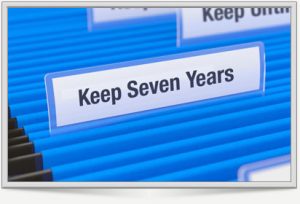
The filing cabinet is overstuffed – what do you really need to keep, and for how long? Here’s a guide that might be helpful:
Permanently:
- Vital records such as birth and death certificates, marriage licenses, divorce decrees, Social Security cards, military discharge papers, wills, trusts, citizenship papers
- IRA contribution records, retirement/savings plan statements, estate planning documents, life insurance contracts
Home improvement records (remodeling, additions, installations), receipts for big purchases such as jewelry, antiques, rugs, appliances, etc. (these might be needed to prove value in case of an insurance claim – but be sure to check with your home insurer - An inventory of your bank safe deposit box (share a copy with your executor or your attorney)
- Pre-paid funeral expenses
Keep these for seven years:
- Tax returns (electronic and paper)
- Canceled checks/receipts (alimony, charitable contributions, mortgage interest and retirement plan contributions)
- Credit card statements if they are tax-related
- Records for tax deductions taken
Keep until the item is sold or paid off:
- Loan documents
- Vehicle titles
- Stocks, bonds, mutual funds, etc.
- Warranties
Keep for less than a year
- ATM and bank-deposit slips, credit-card receipts and bills, until reconciled with your monthly statements
- Insurance policies and investment statements, until new ones arrive
- Paycheck stubs, until you can reconcile with your W2 form
CATEGORY: Personal Finances | January 2nd, 2018 | BY: Neal Pettinelli

